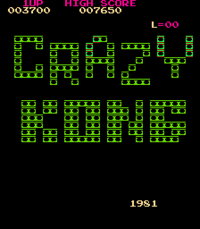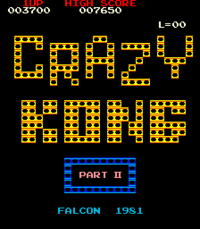Crazy Kong
- This article is about the adaptation of the original Donkey Kong game. For the character referred to as a "Crazy Kong" in the DK Rap, see Lanky Kong.
Crazy Kong is a Nintendo-licensed adaptation of Donkey Kong created in 1981 by Falcon for the Japanese market as the unexpected popularity of the original game led to a shortage of arcade cabinets. The gameplay remains relatively unchanged; however, the sprites suffered enough changes to be differentiated from the original. Nintendo had only authorized for the game to be distributed inside Japan, but Falcon breached this agreement by exporting the game into the US, which prompted Nintendo to terminate the license agreement on January 29, 1982.[1] Like Donkey Kong, this game faced competition from unofficial bootlegs from both arcade clones and home ports.[2] The title Crazy Kong is never used in official Donkey Kong home ports as it has been retired by Nintendo after outliving its usefulness. The game has never been re-released officially in any form.
Differences
- The words "Crazy Kong" are written out of girders on the title screen, similar to Donkey Kong. Below that is the year "1981", with nothing else.
- The color palette is different from Donkey Kong. The girders in 25 m are green, the ape is orange, and Mario's outfit resembles the one from Super Mario Bros..
- Some of the sprite graphics in the game have been redrawn from Donkey Kong. For example, most of the sprites for the gorilla are the same. However, the sprites used for when he is pounding his chest are taller than the original and more fierce.
- Some animation frames have been removed. For example, in 25 m, barrels appear to spawn right out of Crazy Kong, instead of him picking up and rolling them like in Donkey Kong.
- Most of the sound effects in the game are different from Donkey Kong's, due to running on hardware based on that of Crazy Climber. None of the levels have background music.
- Some consider the game to have a higher difficulty than Donkey Kong as the collision detection in the game is not as robust as Donkey Kong's, in addition to parts of the game moving at a faster pace.
- It is possible to complete 25 m by jumping off the second girder from the bottom while Mario's foot is hanging over the ledge. When he jumps off, he should fall through the floor and complete the level. This is a glitch that was carried over from the first version of Donkey Kong.
- The Fires on 100 m are identical to the Fireballs from 25 m, 50 m, and 75 m.
- It is safe to touch the gorilla in 100 m.
- The heart in between Mario and Lady that appears after completing 100 m is now near the round indicator.
Crazy Kong Part II
Falcon addressed several of the problems by releasing Crazy Kong Part II in the same year. Here are the differences from above:
- Under the title, Falcon's name is located next to the year 1981.
- During attract mode, a scene shows Crazy Kong breaking out of his cage. This takes place under Falcon's logo.
- Mario and the gorilla's colors are now fixed but Crazy Kong's animations are still limited.
- The girders of 25 m are now orange and have been shortened so as to not extend past ladders.
- Crazy Kong can no longer be safely touched in 100 m. When he is defeated, the text "GIVE UP!!" appears in the space between him and Mario and Lady.
- Starting from the second level (L=02), two gaps appear in the girders of 25 m. The Conveyor Belts of 50 m move faster. Four platforms in 75 m are shortened.
Lawsuits
Falcon
On June 1, 1982, Nintendo Japan filed for an injunction against Falcon in Kyoto District Court, which was granted on June 5. A countersuit by Falcon was won by Nintendo.[3] On October 13, Nintendo launched a lawsuit seeking damages against Falcon.[4] This experience led Nintendo to decide to produce all Donkey Kong Jr. machines by themselves.[5] Falcon's president was later arrested for unauthorized copying of Donkey Kong Jr. printed circuit boards.[6] The ensuing seven year trial ended with a guilty verdict and prison terms for those involved.[7]
Elcon Industries
On June 30, 1982, Nintendo of America filled a complaint toward Elcon Industries Inc., an arcade hardware manufacturer based in Michigan that sold Crazy Kong boards. The complaint alleged that the licensing agreement with Falcon explicitly forbade the manufacturing or export of Crazy Kong outside Japan. The case was taken to the United States District Court for the Eastern District of Michigan, which quickly ruled in favor of Nintendo.[1]
Trivia
- This is technically the first Mario game in which a character speaks; Mario yells "hi-yah!" whenever he jumps. Ironically, this is a higher pitch version of a gorilla's grunt from Crazy Climber. Lady has unused speech in Donkey Kong, but this was replaced with sound effects before release.[8]
External links
References
- ^ a b Nintendo of America, Inc. v. Elcon Industries, Inc. (October 4, 1982). Google Scholar archive
- ^ Lindell, Martin. The clones of Donkey Kong at VGArc. Retrieved 2 February 2019.
- ^ Game Machine #194 August 15, 1982 issue, page 26
- ^ Game Machine #202 December 1, 1982 issue, page 26
- ^ Game Machine #196 September 15, 1982 issue, page 30
- ^ Game Machine #207 March 1, 1983 issue, page 30
- ^ Game Machine #378 April 15, 1990 issue, page 26
- ^ The Cutting Room Floor



